After the elite and legendary Landaulet, today we talk about one of the most surprising stories in the history of the car: from a simple practical means of transport to real phenomenon of costume, only to fall into oblivion where I am today. Spacious, practical, loved by families and often made fun of the whole house and church for their aesthetic: MPVs are the stars of today's episode of Auto for Dummies. Are you ready? Let's move!
What does “Monovolume” mean and what are the volumes of a car
Let's start with the basics right away: what is a minivan? What does this term mean? To understand this we must start from the beginning, from define the volumes of a car. In fact, you must know that traditionally the volumes of a car are the divisible and distinguishable parts that compose it aesthetically and structurally. There is for example the volume of the hood, where the mechanics are present. The volume of the passenger compartment, dedicated to accommodate all occupants. Then there is the volume of the load, physically and aesthetically separated from the passenger compartment and from the engine, used to load things and objects. The designers say that volume matters since you have to change the trajectory of the pencil to create the silhouette of the car.

As you can see in this side photo, a classic sedan is equipped with three volumes: the bonnet, the volume of the mechanics, the passenger compartment, the volume for the occupants, and the trunk, the volume for the load, all three distinct. The birth of modern cars has led design to prefer this type of construction, different from the unique and very large one still derived from carriages.

With the birth of small cars, however, the two volumes. That is, cars that offered the volume for mechanics and passengers, but which in this volume also "condensed" the volume for luggage. Hatchback cars are recognized precisely for the absence of a separate trunk from the living cell, and for a truncated and vertical tail. An example? The Ford Focus above, the most classic example of a hatchback: hood, cockpit and… that's it.
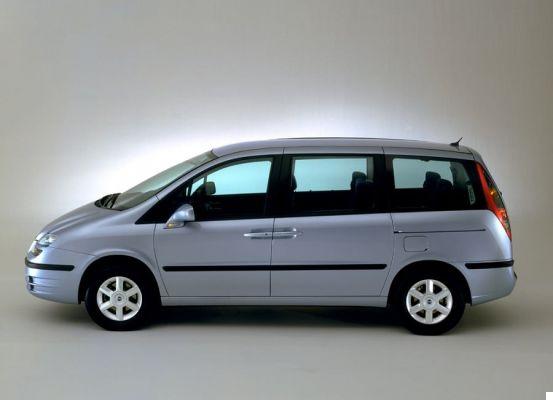
However, it was soon thought that if joining the second and third volumes led to great advantages from the point of view of practicality and interior space, for even more interior space it was possible to condense a short hood, a long, sloping windshield, and a single huge space for luggage, people, animals and whatever else. After a few clumsy attempts and some concepts, the final form was reached: the minivan. The car that to be designed uses a single continuous line for the hood, cockpit and trunk.
How does a MPV differ from other cars?
And aesthetically, MPVs are immediately distinguished by this incredible feature. From every angle, these cars are unlike any other. The front is short and very inclined, and often (but not always, of course) it follows the line of the windshield, which is also rather inclined upwards. Another feature of the minivans is a very large glazing. The windshield itself is huge, to allow you to have a lot of light inside the car, and also all the other windows are large, wide, perfect for giving the perfect light to all the occupants.
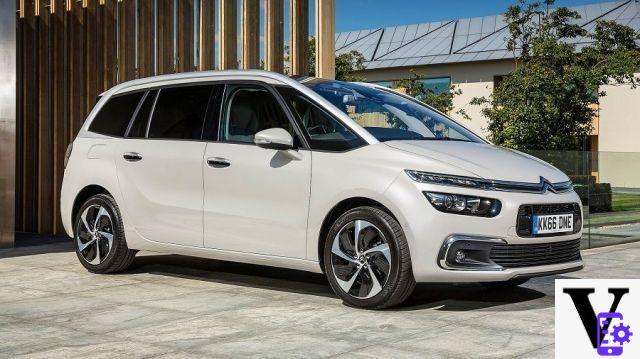
Another feature of the multispaces, another name of these cars, is the high, very high roof. MPVs in fact reach in height the current SUVs, taller than ten or more centimeters compared to classic sedans, without however having their height from the ground. I am therefore "all flab“, And above all all space. The rear is the more classic one, if you like. A super vertical tailgate, with glass surfaces that reach beyond the rear doors, offering light and airiness even to the eventual third row of seats. Yes, because MPVs have always been the most suitable to offer 7 seats, perfect for larger families.

Aesthetically, therefore, minivans have never been true style icons. Sure, there are cars of this type that sported interesting and pleasing lines such as BMW Serie 2 Active Tourer or Ford S-Max, two of the most aesthetically beautiful minivans, or even the pleasant one Opel Meriva second series of 2012, or the latest Kia Carens. But let's talk about a type of cars dedicated to the family, to space for every occasion. Space to bring children, grandparents and mothers-in-law, to play sports, to work, for their hobbies. For this reason, minivans are also known by an Anglo-Saxon term: MPV, Multi Purpose Vehicle, or vehicle with different uses. And this is precisely the real strength of MPVs: being suitable for every use. Well, maybe not racing on the track ...
The kingdom of practicality and family, between rooms and habitability
Where the MPVs then make themselves recognized again is inside of. The setting is often similar to the classic compacts and sedans they start from, but with much more practicality and space. Starting from the dashboard, it is not uncommon to find slightly different solutions, all in the name of practicality and space for things and people.

In fact, MPVs have often offered a central instrument panel. A way to stand out from the basic compact, of course, but also a 'ingenious solution to the problem of storage compartments. Moving the instrument panel to the center frees up a lot of space in front of the steering wheel. This not only helps in terms of visibility, with a freer field of vision, but above all it provides designers with a perfect space to cram a huge glove compartment. But it's not the only one, of course. Plenty of MPVs sported glove boxes under the front seats, under the rear seats, in the doors, in the dashboard, even some in the foot compartments, under the mats.

Finally, some MPVs sported a gem for true storage enthusiasts, that is the shelf above the roof. Thanks to the high roof, in fact, the space on the heads of the front passengers was a lot: for this reason, some minivans were equipped with a real shelf mounted on the roof, perfect for cramming everything, including newspapers, fins for the sea, PCs and who more has more put. Don't shatter me: there have also been classic and traditional minivans, without crazy storage spaces but with neat and elegant interiors and only greater availability of space, such as BMW 2 Series Active Tourer or Mercedes Class B, but in any case all these cars are characterized by plenty of space for people, animals and objects, both in the trunk and inside.

At the rear, the watchword is versatility. The seats are often made up of 3 single armchairs, with forward and backward sliding and sometimes also with the adjustment of the backrest. Then there is a table to eat, play or watch a movie, large windows and lots of space. Finally, the luggage compartment is a real strength of these cars. Compared to the equivalent sedans and compacts, the minivans in fact not only offered 100, 200 or even 300 liters more capacity, but also more versatility, more centimeters in height, and ingenious solutions to increase the load. The seats in the second and, if present, in the third row fold away in just a few steps, forming a flat and uniform load compartment. And if you really want to move around, the larger MPVs allowed the seats to be removed entirely, forming a van load compartment.
The first minivan in history: FIAT 600 Multipla
So these are the modern MPVs: spacious, equipped with many storage compartments, tables, ingenious solutions to make life easier for families and those who use them. However, this has not always been the case. For decades, in fact, those with large families had only one option: a van with three benches. A very spartan vehicle, dedicated to the transport of goods, which, if necessary, was used for the transport of grandparents, children, aunts and so on and so forth.

But in a world that, with the economies of half the world constantly growing, demanded spacious cars for the whole family but capable of being comfortable, refined and cared for, there was still no answer. But this is not to say that there have not been great attempts. Cars remembered as big misunderstand, you just arrive too early. The greatest example of this is one true icon of Italian motoring, as misunderstood and mistreated when it was new, as admired and appreciated over 50 years later. Let's talk about the FIAT 600 Multipla from 1956. A truly revolutionary and never before seen car, chand anticipated the first modern minivan by nearly 30 years, the Renault Espace from 1984.
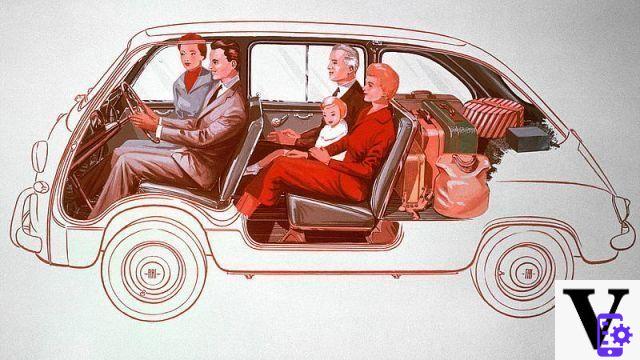
Born just under a year after the 600 of '55, it was based in all respects on the small compact Turin. If, however, the mechanical base and the rear engine, the legendary 100 cm633 Series 3, were the same, the aesthetics were totally revolutionized. The front volume of 600, where the tank, spare wheel and luggage compartment were housed, had been completely eliminated. In its place, a vertical and unprecedented front, with the driver seated in front of the front axle. This gave the 600 Multipla an absurd aesthetic, with a less aerodynamic front than the rear, so much so that at the time it was made fun of by saying that they had it in the factory “Mounted upside down”.
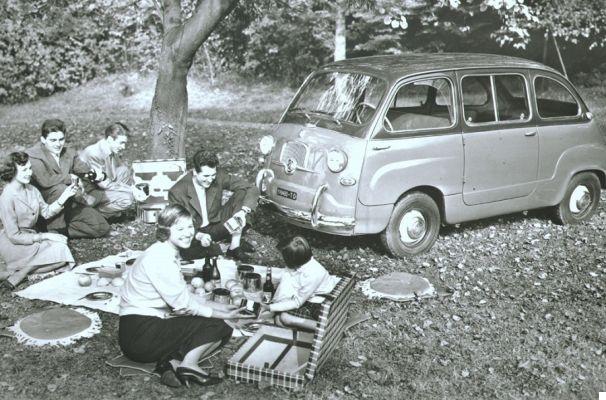
In fact, this solution left one incredible amount of space for passengers. In fact, if the front bench was for two or three people, two traditional doors appeared behind them, opposed to the front doors, which allowed access to the rear seats. Here was available both a version with a fully foldable bench in the cargo bed, capable of accommodating up to three people, or configuration a 6 seats, with 4 single folding seats. When these were in place, the 600 Multipla offered 4 to 6 seats, with also a large luggage compartment between the rear seat backrests and the engine compartment, or a huge compartment for objects, things or even to cram a mattress.

In fact, FIAT had understood the great potential of their minivan. A car not only dedicated to small artisans, to convents to transport Sisters and friars or to football teams, but also for the leisure, sport, hobbies and trips out of town. In the end, however, its strange aesthetics and lack of understanding of the concept relegated it to the uses mentioned in convents, in small football or basketball teams or at markets. There was, however, an area where it defeated all competition: i taxi. FIAT 600 Multipla became one of the most popular taxis in Italy and Europe, thanks to its city-proof size and handling and plenty of space. She ended her career in 1967, and only now, more than 60 after her debut, has she finally been understood.
Launch Megagamma, the missed opportunity
The MPV scene after the 600 Multipla flop has quieted down for years. Large families opted for vans like the Volkswagen Transporter, FIAT 850T or Ford Transit, and the demand for spacious and neat family cars seemed to be gone forever. Over the years, however, the houses have not stopped. The development of this type of multi-purpose car capable of satisfying different lifestyles went on, because it seemed that there was room for this new slice of the market.

The turning point came between the 70s and 80s. In America there was a desire to create a more refined, spacious, more family-friendly van. So the Big Three, GM, Chrysler and Ford, got to work on this project. At the same time, however, the closest to launching the first modern minivan were the Alfa Romeo teams but above all Lancia. In 1976, in fact, Alfa Romeo had designed the New York Taxi, a project made by Bertone of a spacious minivan for the American city, which never went through the port. Bertone, however, working on the project, realized his goodness, and proposed the same formula to spear. The Borgo San Paolo House accepted to make a prototype, the Lancia Megagamma from 1978. The Megagamma, as the name implies, was built on the floor of the Gamma midsize sedan, from which it also took the 2.5 boxer engine and excellent road holding.

Aesthetically, it was the prototype of a modern minivan, with all the stylistic features we talked about before. The roof was of 25 cm higher than the starting range, and the space inside was excellent, even with the flat floor. But most of all, both outside and inside it was ready for production: she lacked nothing at all, she was ready for sales. Unfortunately, however, as has often happened before and will happen later, the FIAT management, owner of Lancia, judged the project "too risky". FIAT therefore did not even give the green light to the creation of prototypes for road tests, trashing the project after the excellent reception of the public and professionals. One of the most classic wasted opportunities in the history of the FIAT Group.
Renault Espace, the first modern minivan is from 1984
The 1978 Lancia Megagamma was an incredible missed opportunity also because in that way the world found it wanted that kind of car. That prototype also had resonance in the United States, which in 1983 saw its first minivan, the American-style minivan, Chrysler Voyager. In Europe, however, the story is much more complex, but connected to the Chrysler Voyager.

The first European minivan had an incredibly troubled history. Everything comes from Matra, histrionic and crazy French manufacturer that has given over the years the first SUV (or almost), the Rancho, two coupé with three seats, the Murena and the Bagheera, and also capable of win a Formula 1 Championship in 1969 with Sir Jackie Stewart at the wheel. In all of this, Matra's madness and expensive solutions made her a real loose cannon in the automotive world. Part of the Simca Group, it collaborated with the PSA Group, but also with BMW and other manufacturers. The Matra management, part of the Simca-Talbot-Chrysler Group in the late 70s, during a visit to the United States he saw the prototype of the Voyager, and it was love at first sight. They had to build one too.

The project P16 it was born immediately after the visit in the late 70s, and went on for several years. The reason? Matra did not have the resources to build it with its own brand: it had to convince another company to produce it. The chosen one should have been the PSA Group, which controlled 49% of Matra. Peugeot and Citroen, however, were not at all convinced, thinking that such a strange model could only turn out to be a waste of money. Before Matra then proposed it to BMW, with whom he had been collaborating for years, he joined Renault, who saw the potential of this car and also wanted to outsmart his archenemies of the PSA Group. After several negotiations, which led to the disappearance of the double name Renault-Matra and the purchase by Losanga of the shares of Matra held by PSA, in 1984 the Espace finally arrived.

In 1984 it looked like a car from another planet. Espace sports a wedge line, high, very spacious, with lots of glass and a fiberglass body, a classic Matra. The lines and versatility earned it the nickname of TGV for families, on the enthusiasm of the brand new French high-speed train born in those years. Espace is light, very spacious and equipped with powerful petrol and turbodiesel engines, but above all it is incredibly versatile. Inside, they are arranged three rows of individual seats, two in front, two in the middle and three in the rear.

These seats can be rotated, folded down, adjusted, folded, made a coffee table and even removed, to create a place to chat, play, have lunch or a huge load compartment. The minimum load capacity is 850 liters, with over 3500 liters available by folding down the seats. All with just 4,3 meters in length, less than a FIAT Tipo. Produced until 1990, with 4 successive generations Espace is still in production today, becoming one of the most successful minivans of all.
Success in the 2000s: Everyone wants MPVs
Espace remained unique until the 90s, when you are multiply your rivals from Germany, France, Italy and even Japan, with the insane mid-engined, rear-wheel drive Toyota Previa. The MPVs then continued their rise, first dedicated only to larger cars such as FIAT Ulysse, Lancia Zeta or Volkswagen Sharan before arriving at carried out in the '00s. In this decade, there has been a real one boom of minivans.

The public wanted space, practicality and that sense of having a car capable of being suitable for any situation. This is why some were born first medium minivan, such as Volkswagen Touran, Renault Mégane-Scenic, Citroen Xsara Picasso and our beloved FIAT Multipla, the first medium-sized minivan launched in 1998. But then the small minivans were born: in the dimensions of cars such as FIAT Punto, Lancia Ypsilon or Opel Corsa are born small spacious minivans, with a squat and high line and a lot of practicality, such as FIAT Idea, Lancia Musa, Opel Meriva.
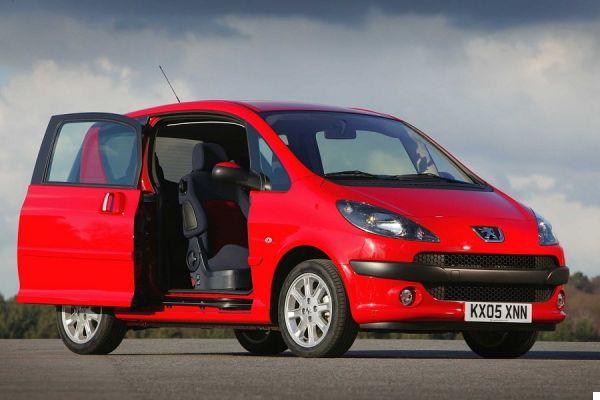
In the early '00s there were on the market expensive and neat minivans, like Mercedes B-Class, or monovolume crazy such as Peugeot 1007 with two electric sliding doors, but also Sporty and beautiful to drive MPVs like Ford S-Max and Mazda 5. Also dseveral compact cars took up the stylistic features of minivans like Mazda 2, Mitsubishi Colt and above all FIAT Panda. The second Panda series in fact completely changed the recipe of the first Pandino, increasingly resembling a very small, compact and versatile minivan.
The arrival of SUVs and the decline of minivans: very few left on the list
In the early 10s of the Third Millennium it seemed that no one could stop minivans. The houses have begun to improve the engines, aesthetics and technology. MPVs were born that are really accurate and particular, like the Opel Meriva with closet doors, or the Toyota Prius + hybrid. The problem, however, was not the products, but rather the taste of the public, totally changed in a few months. Following the 2007 launch of the Nissan Qashqai, the i a SUV that used to be huge and bulky are got smaller and smaller.

Families found that, by losing some practicality, they could have an even higher driving position, an off-road aesthetic but still have an excellent availability of space. And you know, the public is the master. Thus, the Opel Meriva took over the Mokka and the Crossland, the Ford C-Max the Puma and the Kuga, and so on.. Have remained very few “true” MPVs: FIAT 500L, Ford S-Max and Galaxy, Renault Scénic, Toyota Prius + and the luxurious BMW 2 Series Active Tourer Mercedes B-Class.

Another cause of the decline of minivans is the continuous improvement of commercial vehicle derivatives. Vehicles that up to 15/20 years ago were poorly cared for from an aesthetic, technical and qualitative point of view are now much more "cars" than ever. Models like Renault Kangoo, Volkswagen Caddy or Peugeot Rifter are now beautiful to look at, functional and cared for. All this has led the minivans to a slow but inexorable decline, which today relegates them to a niche role on the market.
But does it still make sense to buy a minivan? What are the best modern minivans?
But in our opinion they do not deserve this end. MPVs are much smarter and more spacious than a classic sedan or a trendy SUV. They offer a lot of space, a practicality that cannot be found on other cars, a particular aesthetic and the possibility of satisfying any type of need. Next week we will see what are the best minivans for those who need space, practicality and versatility, for less than the price of the cheapest SUV, Dacia Duster. Are you curious to know them? Bring all your favorite family members, dogs and hobbies… they all fit, I promise! See you next Friday, always here at Auto for Dummies! Hi!
 OPO 10 - Car 1/48 Mercury Collection by Hachette: Fiat 600 ...
OPO 10 - Car 1/48 Mercury Collection by Hachette: Fiat 600 ...
- This item is a Hachette replica of the original Mercury product
- It differs from that of the time for a much better quality of molding and painting.
 Rovtop Car Trunk Organizer, Trunk Bag ...
Rovtop Car Trunk Organizer, Trunk Bag ...
- 【Large capacity and multiple pockets】: Rovtop Car Trunk Organizer includes 9 pockets: 4 solid mesh pockets ...
- 【Waterproof, sturdy and machine washable material】: Rovtop car trunk organizer is made of 600D Oxford ...
- 【Suitable for almost all cars】: Perfect size - 37 "* 17" / 94CM * 43CM long and wide, this case is ...




















![[Review] Samsung Powerbot VR7000: the robot vacuum cleaner from Star Wars](/images/posts/6bc44de38605b5c0fa12661febb1f8af-0.jpg)





